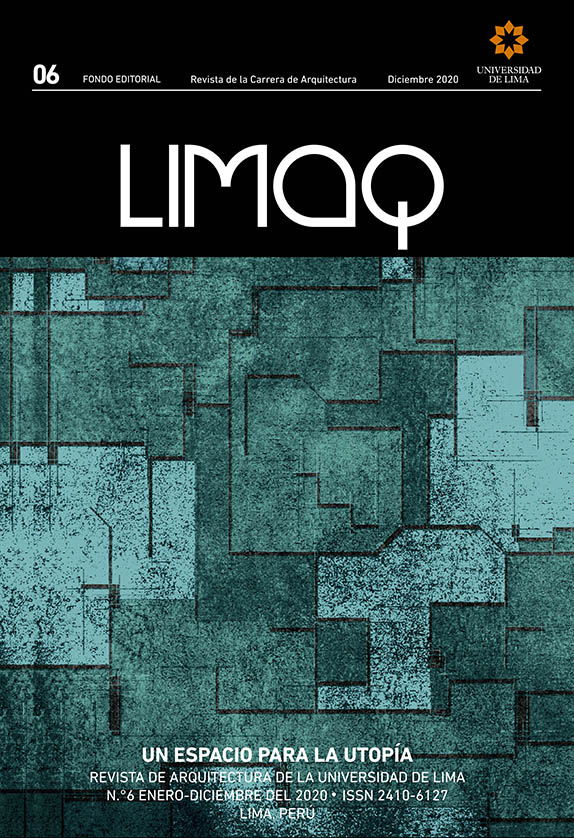Exploración de la domótica emocional: una propuesta sensorial en la relación hombre-espacio
DOI:
https://doi.org/10.26439/limaq2020.n006.4821Palabras clave:
domótica emocional, ambientes interiores inteligentes, relaciones humano-espacialesResumen
La arquitectura refleja la intencionalidad del diseñador por transformar el espacio y contribuir a la percepción de confort del usuario. En este proceso integra tecnologías de la información y comunicación —domótica— intensificando su interacción con diversos elementos del entorno. Su aplicación ha permitido hasta ahora la comunicación unidireccional del usuario con el espacio, pero al incorporar el reconocimiento inteligente de emociones se transforma en bidireccional posibilitando la respuesta del espacio, adaptándose. El presente artículo explora este cambio radical en la relación usuario-espacio y propone un modelo conceptual basado en el
confort como punto de partida para profundizar en su estudio.
Descargas
Referencias
Aiello, M., Marchese, M., Busetta, P., y Calabrese, G. (2004). Opening the Home: A Web service approach to domotics. Trento: University of Trento.
Al Horr, Y., Arif, M., Katafygiotou, M., Mazroei, A., Kaushik, A., y Elsarrag, E. (2016). Impact of indoor environmental quality on occupant well-being and comfort: A review of the literature. International Journal of Sustainable Built Environment, 5(1), 1-11.
Barsky, J., y Nash, L. (2002). Evoking Emotion: Affective Keys to Hotel Loyalty. The Cornell Hotel and Restaurant Administration Quarterly, 43(1), 39-46.
Bollnow, O. F., y D’Ors, V. (1969). Hombre y espacio. Barcelona: Labor.
Bujdei, C., y Moraru, S. A. (2011). Ensuring Comfort in Offi ce Buildings: Designing a KNX Monitoring and Control System. En 2011 Seventh International Conference on Intelligent Environments (pp. 222-229).
De Carvalho Correia, A. C., De Miranda, L. C., y Hornung, H. (2013). Gesture-based interaction in domotic environments: State of the art and HCI framework inspired by the diversity. En IFIP Conference on Human-Computer Interaction (pp. 300-3017).
Eisenhardt, K. M. (1989). Building theories from case study research. Academy of management review, 14(4), 532-550.
Ekman, Paul and Keltner, Dacher (1970). Universal facial expressions of emotion. California mental health research digest, 8(4), 151-158.
El Murabet, A., y Abtoy, A. (2019). Understanding the Ambient Assisted Living systems: concepts, architectural trends and challenges. International Journal of Open Information Technologies, 7(1).
Fernández-Caballero, A., Martínez-Rodrigo, A., Pastor, J. M., Castillo, J. C., Lozano-Monasor, E., López, M. T., et al. (2016). Smart environment architecture for emotion detection and regulation. Journal of biomedical informatics, 64, 55-73.
Fich, L. B., Jönsson, P., Kirkegaard, P. H., Wallergård, M., Garde, A. H., y Hansen, Å. (2014). Can architectural design alter the physiological reaction to psychosocial stress? A virtual TSST experiment. Physiology y behavior,135, 91-97.
Fransson, N., Västfjäll, D., y Skoog, J. (2007). In search of the comfortable indoor environment: A comparison of the utility of objective and subjective indicators of indoor comfort. Building and Environment, 42(5), 1886-1890.
Hirsch, P. M., y Levin, D. Z. (1999). Umbrella advocates versus validity police: A life-cycle model. Organization Science, 10(2), 199-212.
Montalbana, I., Garzo, A., y León, E. (2009). Emotion-aware intelligent environments: A user perspective. Intelligent Environments, 421-428.
Navarro-Tuch, S. A., Bustamante-Bello, M. R., Ávila-Vázquez, R., Izquierdo-Reyes, J., Ramírez-Mendoza, R., Pablos-Hach, J. L. y Gutiérrez-Martínez, Y. (2016). Emotional domotics: Inhabitable space variable control for the emotions modulation. In Springer (Ed.), Proceedings of SAI Intelligent Systems Conference (1034-1042).
Navarro-Tuch, S. A., Bustamante-Bello, M. R., Molina, A., Izquierdo-Reyes, J., Ávila-Vázquez, R., Pablos-Hach, J. L., y Gutiérrez-Martínez, Y. (2018). Inhabitable space control for the creation of healthy interactive spaces through emotional domotics. International Journal on Interactive Design and Manufacturing (IJIDeM), 12(4), 1337-1347.
Russell, J. A. (1980). A circumplex model of affect. Journal of Personality and Social Psychology, 39(6), 1161-1178.
Ryu, K., y Jang, S. (2008). Retracted Article: Infl uence of restaurants’ physical environments on emotion and behavioral intention. The Service Industries Journal, 28(8), 1151-1165.
Stanley Okwudili, A. (2015). The influence of architecture on human behavior. Epoch of Science. Recuperado de https://elibrary.ru/item.asp?id=25429527
Valencia, H. (2019). Domótica emocional, el sistema que te cambia el ánimo. Recuperado de http://cienciamx.com/index.php/ciencia/salud/15922-domotica-emocional-sistema-animo



